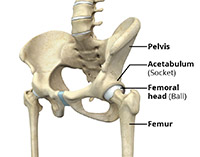



Classically a fall leads to a painful hip with an associated inability to walk. Most hip fractures can be diagnosed, or at least suspected, from history alone. Arguably many more hip fractures could be described as pathological due to underlying osteoporosis, but this group is rarely labeled in this way. The two most frequent causes in relation to hip fractures are malignancy and bisphosphonate use. A pathological fracture is defined as a fracture caused by a disease process and not related to trauma. These patients are likely to have incurred multiple injuries and should be assessed and managed appropriately as per local trauma guidelines.Īround 5% of hip fractures have no history of trauma, and in these cases, an alternative cause should be suspected. Hip fractures that occur in younger adults are often the result of high-energy trauma. Many patients have multiple risk factors, and this, along with age-associated reduced bone quality, is the underpinning cause of most hip fractures. Risk factors for falls in the elderly population are numerous, but those with a strong independent association are a previous history of falls, gait abnormalities, the use of walking aids, vertigo, Parkinson disease, and antiepileptic medications. The majority of hip fractures are the result of a fall in the elderly population.


 0 kommentar(er)
0 kommentar(er)
